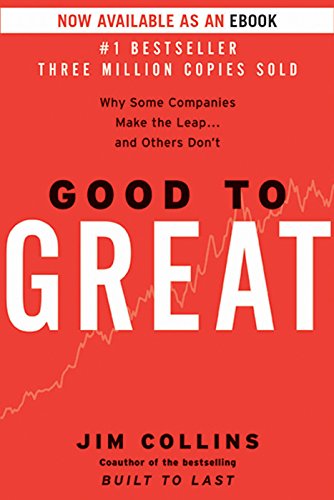

This article is an excerpt from the Shortform summary of "Good to Great" by Jim Collins. Shortform has the world's best summaries of books you should be reading.
Like this article? Sign up for a free trial here .
What makes a business successful? How can you turn a good business into a great one?
In the process of analyzing and coding the various facets of the good-to-great companies and their comparisons, Jim Collins and his team were clued into key concepts by a number of surprising differences. Learn what makes a business successful, from Good to Great.
What Makes a Business Successful? Key Factors
- High-profile, celebrity CEOs brought in from the outside to whip a company into shape actually hurt a company’s ability to transition from good to great.
- “Strategy”—that is, the formulation of a long-term plan of any kind—didn’t correlate with good-to-great. Both the good-to-great companies and the comparison companies had long-term strategies in place.
- Technology was insignificant as far as starting a transition from good-to-great. It helps hasten a transformation, but isn’t required for a transformation to begin.
- Mergers and acquisitions were not a cause of greatness.
- Good-to-great transformations weren’t highlighted by a press release, announcement, rollout, or anything at all. Rather, they were the result of steady, dogged work that, to observers inside the company and out, seemed perfectly ordinary—even boring.
- The particular industry wasn’t important: Some good-to-great companies specialized in unglamorous areas yet were able nevertheless to produce great results.
So how did the good-to-great companies do it? What makes a company successful? Collins provides a tidy chronological diagram that details the companies’ unique traits.
Buildup Phase
- People
- Level 5 Leadership: Good-to-great companies are led by “Level 5” leaders—personally humble but professionally driven executives.
- The Right Team: Having the right people on board early pays dividends down the line.
- Thought
- Facts Over Fantasy: Companies need to develop a culture where brutal truth is heard (but hope springs eternal).
- Facts Over Fantasy: Companies need to develop a culture where brutal truth is heard (but hope springs eternal).
Breakthrough Phase
- Hedgehog Thinking: To think like a hedgehog, rather than a fox, is to develop a simple guiding concept for your organization.
- Action
- Disciplined Culture: The organization from top to bottom needs to understand and adhere to the “Hedgehog Concept.”
- Tech Done Right: Good-to-great companies never latch onto new technology for its own sake. They use tech to accelerate transitions, not create them.
The buildup and breakthrough phases are part of what makes a business successful.
To head off the notion that these features can be implemented or cultivated overnight, Collins and his team came up with the “flywheel” analogy. A heavy flywheel takes an enormous amount of energy to get going—but once it’s spinning, it only takes a small amount of energy to keep it turning or to increase its speed. Good-to-great companies achieve their key strengths steadily and doggedly; they stay patient in the confidence that, with the right cogs in place, the breakthrough will come. Maintaining the flywheel is what makes a business successful.
The opposite of the flywheel is the “doom loop.” A company that tries to revolutionize its strategy, culture, product, or process in one fell swoop is fated to fail.
What Makes a Company Successful?
The great companies followed six essential factors:
1. Cultivating Singular Leadership
Good-to-great companies have what Collins et al. call “Level 5” leaders. Level 5 leaders are personally humble, almost shy, but highly driven professionally—more like Lincoln than Patton.
They avoid the limelight and tend to credit exterior forces or colleagues for their companies’ successes. Although they’re often personally likable and inspiring, they’re not usually “charismatic.”
Their lack of ego enables them to concentrate on one thing and one thing only: the company’s success. This is a factor in what makes a business successful.
How to achieve it: Collins admits that Level 5 characteristics are likely a product of both nature and nurture and so are difficult to create out of whole cloth; he also doesn’t have hard data to back up any suggestions he might make. His best advice for aspiring Level 5 leaders is to follow the other precepts he outlines. That way, even if you aren’t a Level 5 leader, you’ll at least be acting like one.
2. Assembling the Right Team
This is another factor in what makes a business successful. Good-to-great companies retain the right people before embarking on any specific program.
A good-to-great team is composed of people who care deeply about the company and will argue passionately for the decisions they believe are right (but will come together to support whatever decision is eventually reached).
Avoid at all costs the “genius with a thousand helpers” model; management teams should be composed of independent and critical thinkers, not “yes people.”
How to achieve it: (1) Don’t hire until you’re sure you have the right person; (2) recognize when you need to make a change (whether by shifting a role or letting someone go) and act swiftly; and (3) assign your best people to your biggest opportunities rather than your biggest problems.
3. Unearthing and Facing Facts
Good-to-great companies are evangelical about recognizing market realities and reacting in kind.
That said, no matter how dire the facts, they never lose faith that, eventually, they’ll prevail.
The key is to be stoic yet hopeful, realistic without turning cynical.
How to achieve it: With the right management team—one comprising sharp, critical thinkers—the facts should never be in short supply. Leaders can encourage truth-telling by: (1) Beginning meetings with questions, not answers; (2) cultivating, rather than stifling, debate among the team; and (3) conducting clear-eyed analyses of mistakes without assignation of blame.
4. Thinking Like a Hedgehog
“Foxes” know many things and see the world in all its complexity, whereas “Hedgehogs” know one big thing and order the world according to that thing.
A good-to-great company thinks like a hedgehog by developing a “Hedgehog Concept”—an elegant, easy-to-understand guiding philosophy based on facts—that it adheres to fanatically. This is the fourth factor in what makes a business successful.
How to achieve it: A company’s “Hedgehog Concept” is derived from the answer(s) to three questions: (1) At what can I be the best in the world? (2) What is my financial engine? And (3) What am I profoundly passionate about?
5. Maintaining Discipline
Good-to-great companies make the jump because they constantly refer to and consistently realize their Hedgehog Concepts. Rigorous adherence to a Hedgehog Concept saves companies from panic acquisitions or misguided projects.
Good-to-great companies also lack the administrative and managerial burdens of other companies—with the right people in place and an easy-to-understand Hedgehog Concept, the need for tight management or layers of bureaucracy withers away. Discipline does not mean a tyranny presided over by the executive.
How to achieve it: (1) Allow individuals freedom within a clear framework of responsibility; (2) retain self-disciplined people who are driven to produce results; (3) recognize that a disciplined culture is different from a culture led by a tyrant or disciplinarian; and (4) adhere fanatically to hedgehog thinking. A key technique for staying true to your Hedgehog Concept? Create a “stop doing” list.
6. Using Technology Tactically
For good-to-great companies, technology isn’t the creator of great results but their accelerant.
Rather than follow technological fads and adopt new technology for its own sake, good-to-great companies pioneer particular uses of new technology.
How to achieve it: When evaluating a new technology, the key question to ask is: How does this technology impact my Hedgehog Concept? If it doesn’t, you can safely ignore it and/or accept parity in its use; if it does, you must figure out how you can lead in the application of that technology. This is one of the final factors that determine what makes a business successful.
———End of Preview———

Like what you just read? Read the rest of the world's best summary of "Good to Great" at Shortform . Learn the book's critical concepts in 20 minutes or less .
Here's what you'll find in our full Good to Great summary :
- The 3 key attributes of Great companies
- Why it's better to focus on your one core strength than get spread thin
- How to build a virtuous cycle, or flywheel effect, in your business






